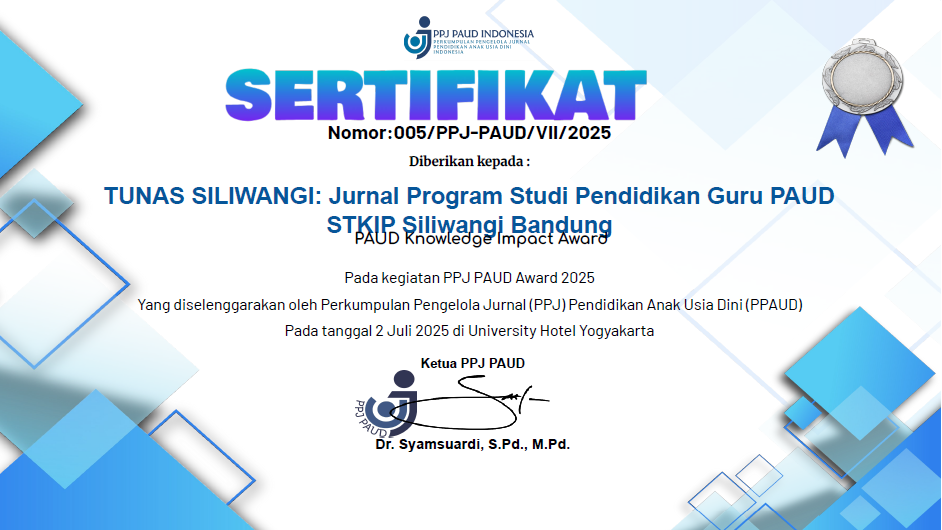Perilaku Orangtua Dalam Menstimulasi Anak Pada Masa Kandungan (Prenatal)
DOI:
https://doi.org/10.22460/ts.v8i2p90-100.2794Abstract
Prenatal stimulation is an adult's conscious effort to develop all of each person's potential to develop optimally, in sync with the development of each child. Ideally both parent and mother can implement child stimulation within the womb. However, parents have been found to have a roadblock to application of prenatal stimulation, a lack of family social support. Benefits derived, along with parents knowing information related to stimulating children in prenatal times, parents may also become cadres that can eventually cross one another. A common goal in this study is to analyze the behavior of core family members in stimulating the development of children made by both father and mother. The study used a quantitative descriptive method using the survey method using a targeted sample of 150 domestic heads (KK). Research indicates that most parents have prenatal child stimulation behaviors, especially with 100% or total parental physical stimulation. Much of the behavior that has been done is religious and immoral by 97%, mothers' health stimulation by 80%, 61% cognitive stimulation, and a small percentage go through art of 41%. The medical condition of an expectant mother is affected by the emotional social condition of 59% of cravings and stress.References
Al Mutairi, A. O. (2018). The descriptive statistics for the generalized power function distribution. Journal of Statistics and Management Systems, 21(5), 775–785. https://doi.org/10.1080/09720510.2018.1453680
Alfiyah, S. N. (2018). Implementasi pendidikan pranatal dalam Islam: studi atas ibu hamil di Desa Kajen Margoyoso Pati. UIN Walisongo.
Ates, H., & Alsal, K. (2012). The Importance of Lifelong Learning has been Increasing. Procedia - Social and Behavioral Sciences, 46, 4092–4096. https://doi.org/10.1016/j.sbspro.2012.06.205
Brodbelt, S. (1983). Education as growth: Life-long learning. The Clearing House, 57(2), 72–75.
Cao-Lei, L., De Rooij, S. R., King, S., Matthews, S. G., Metz, G. A. S., Roseboom, T. J., & Szyf, M. (2020). Prenatal stress and epigenetics. Neuroscience & Biobehavioral Reviews, 117, 198–210.
Cavallaro, M., & Fidell, L. (1994). Basic Descriptive Statistics: Commonly Encountered Terms and Examples. American Journal of EEG Technology, 34(3), 138–152. https://doi.org/10.1080/00029238.1994.11080483
Creswell, J. W. (2002). Desain penelitian. Pendekatan Kualitatif & Kuantitatif, Jakarta: KIK.
Cruz, S., Lifter, K., Barros, C., Vieira, R., & Sampaio, A. (2020). Neural and psychophysiological correlates of social communication development: Evidence from sensory processing, motor, cognitive, language and emotional behavioral milestones across infancy. Applied Neuropsychology: Child, 1–20. https://doi.org/10.1080/21622965.2020.1768392
Fahimah, I. (2019). Kewajiban orang tua terhadap anak dalam perspektif islam. Jurnal Hawa: Studi Pengarus Utamaan Gender Dan Anak, 1(1).
Falck, S. (2020). The psychology of intelligence. The Psychology of Intelligence, 42(9), 1–127. https://doi.org/10.4324/9781003042365
Hammick, M. (1998). Interprofessional education: concept, theory and application. Journal of Interprofessional Care, 12(3), 323–332.
Hanfstingl, B., Benke, G., & Zhang, Y. (2019). Comparing variation theory with Piaget’s theory of cognitive development: more similarities than differences? Educational Action Research, 27(4), 511–526. https://doi.org/10.1080/09650792.2018.1564687
Harris, J. M., Franck, L., & Michie, S. (2012). Assessing the psychological effects of prenatal screening tests for maternal and foetal conditions: a systematic review. Journal of Reproductive and Infant Psychology, 30(3), 222–246.
Hidayati, N. (2016). Beban ganda perempuan bekerja (antara domestik dan publik). Muwazah: Jurnal Kajian Gender, 7(2).
Jember, D. I. (2019). Implementasi Pendidikan Pranatal Persepektif Islam (Studi Atas Ibu Hamil di Desa Bloro Besuki Situbondo). Indonesian Journal of Islamic Teaching, 2(2), 83–96.
Juwantara, R. A. (2019). Analisis Teori Perkembangan Kognitif Piaget Pada Tahap Anak Usia Operasional Konkret 7-12 Tahun Dalam Pembelajaran Matematika. Jurnal Ilmiah Pendidikan Guru Madrasah Ibtidaiyah, 9(1), 27–34.
Kania, N. (2006). Stimulasi tumbuh kembang anak untuk mencapai tumbuh kembang yang optimal. Bandung: Universitas Padjajaran.
KS, N., & SN, G. (2020). Leisure reading experience promoting prenatal attachment among pregnant women: A moderated mediation model. Journal of Leisure Research, 1–29.
Kurtz, L., & Derevensky, J. L. (1994). Family configuration and maternal employment: Effects on family environment and children’s outcomes. Journal of Divorce and Remarriage, 22(1–2), 137–154. https://doi.org/10.1300/J087v22n01_10
Lawson, K. (1982). Lifelong education: concept or policy? International Journal of Lifelong Education, 1(2), 97–108.
Leithner, K., Maar, A., & Maritsch, F. (2002). Experiences with a psychological help service for women following a prenatal diagnosis: results of a follow-up study. Journal of Psychosomatic Obstetrics & Gynecology, 23(3), 183–192.
Lynn, S. K. (1994). Create an Effective Learning Enviroment. Strategies, 7(4), 14–17. https://doi.org/10.1080/08924562.1994.10591971
McENTEE, E. F. (1977). Measures in descriptive statistics A formal outline. International Journal of Mathematical Education in Science and Technology, 8(1), 59–63. https://doi.org/10.1080/0020739770080108
Muliadi, D. (2015). Sistem Kesehatan Nasional (Skn) (pp. 7–37). Jakarta.
Olds, D. L. (1990). The Prenatal/Early Infancy Project: a strategy for responding to the needs of high-risk mothers and their children. Prevention in Human Services, 7(1), 59–87.
Pramudia, R. J. (2013). Belajar Sepanjang Hayat: Konsep, Kebijakan dan Aplikasi dalam Pendidikan Non Formal Menuju Masyarakat Berpengetahuan. Bandung: Edukasia Press.
Purnomo, P., Hufad, A., & Wahyudin, U. (2020). Journal of Nonformal Education. 4(1).
Rayna, S., & Laevers, F. (2011). Understanding children from 0 to 3 years of age and its implications for education. What’s new on the babies’ side? origins and evolutions. In European Early Childhood Education Research Journal (Vol. 19, Issue 2, pp. 161–172). Taylor & Francis. https://doi.org/10.1080/1350293X.2011.574404
Riggio, H. R., & Desrochers, S. J. (2006). Maternal employment: Relations with young adults’ work and family expectations and self-efficacy. American Behavioral Scientist, 49(10), 1328–1353. https://doi.org/10.1177/0002764206286558
Rose, J., & Thorburn, J. (2018). Helping Babies and Children Aged 0–6 to Heal after Family Violence: A Practice Guide to Infant- and Child-led Work. In Australian Social Work (Vol. 71, Issue 2). Jessica Kingsley Publishers. https://doi.org/10.1080/0312407x.2018.1425968
Rovei, V. (2010). Family planning, fertility awareness and knowledge about Italian legislation on assisted reproduction among Italian academic students. Reproductive BioMedicine Online, 20(7), 873–879. https://doi.org/10.1016/j.rbmo.2010.03.024
Slater, P. J. B. (1981). Baby knows best: The physiology of pregnancy and lactation. Journal of Biological Education, 15(1), 8–10. https://doi.org/10.1080/00219266.1981.9654327
Soetjiningsih. (2014). Tumbuh Kembang Anak. Kencana Prenada Media Group.
Sugiyono. (2015). Metode penelitian kuantitatif, kualitatif dan R & D. Alfabeta.
Van den Bergh, B. R. H., van den Heuvel, M. I., Lahti, M., Braeken, M., de Rooij, S. R., Entringer, S., Hoyer, D., Roseboom, T., Räikkönen, K., & King, S. (2020). Prenatal developmental origins of behavior and mental health: The influence of maternal stress in pregnancy. Neuroscience & Biobehavioral Reviews, 117, 26–64.
Veru, F., Laplante, D. P., Luheshi, G., & King, S. (2014). Prenatal maternal stress exposure and immune function in the offspring. Stress, 17(2), 133–148.
Weiss, S. J., Wilson, P., & Morrison, D. (2004). Maternal Tactile Stimulation and the Neurodevelopment of Low Birth Weight Infants. Infancy, 5(1), 85–107. https://doi.org/10.1207/s15327078in0501_4
Downloads
Published
Issue
Section
License
Copyright (c) 2025 Purnomo Purnomo, Eko Sulistiono, Joni Rahmat Pramudia, Cucu Sukmana

This work is licensed under a Creative Commons Attribution-ShareAlike 4.0 International License.
The author is responsible for acquiring the permission(s) to reproduce any copyrighted figures, tables, data, or text that are being used in the submitted paper. Authors should note that text quotations of more than 250 words from a published or copyrighted work will require grant of permission from the original publisher to reprint. The written permission letter(s) must be submitted together with the manuscript.







